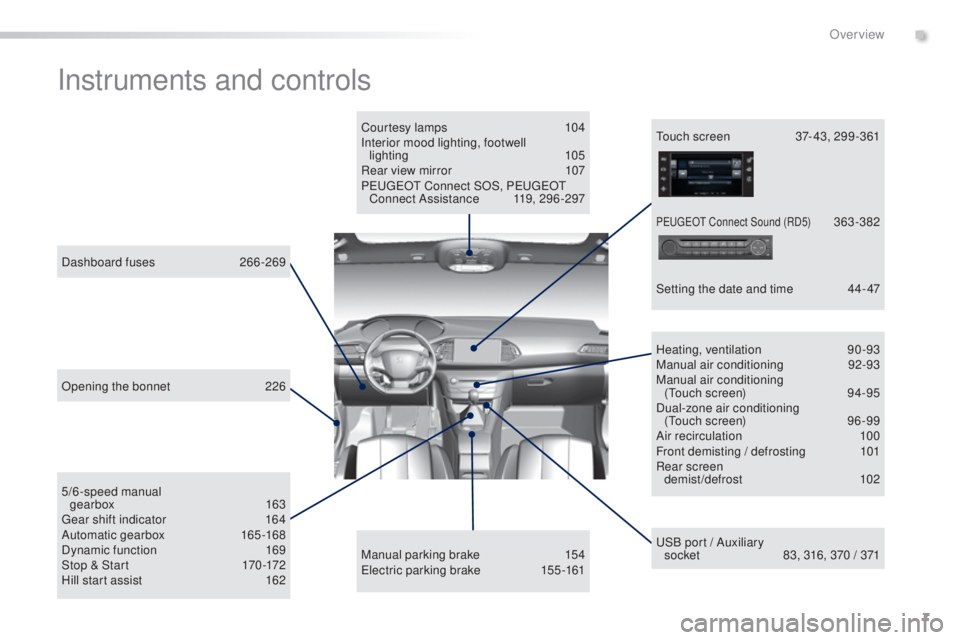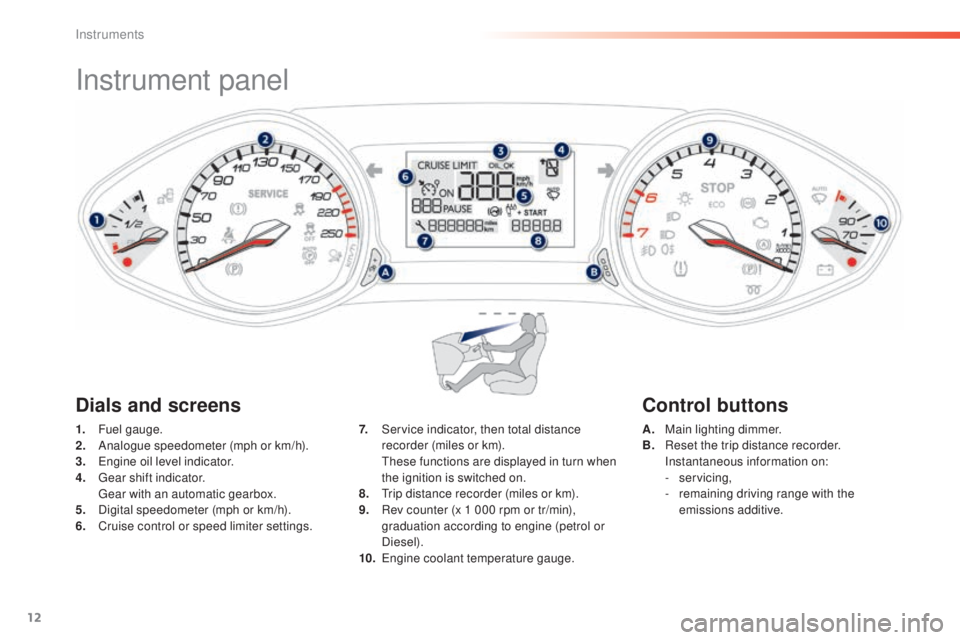2016 Peugeot 308 light
[x] Cancel search: lightPage 4 of 398

.
.
308_en_Chap00a_sommaire_ed02-2015
Over view
Instrument panel 12
I ndicator and warning lamps
13
gau
ges and indicators
28
D
istance recorders
32
tri
p computer
34
tou
ch screen
37
S
etting the date and time
44 R
emote control key
48
"
Keyless
ent
ry and Starting" with
remote
c
ontrol
54
"
Keyless
ent
ry and Starting"
on your person
56
Boo
t
59
A
larm
6
5
ele
ctric windows
69
P
eu
ge
Ot i
- Cockpit
71
S
teering wheel adjustment
71
F
ront seats
72
R
ear seats (hatchback)
77
R
ear seats (SW)
78
I
nterior fittings
80
F
ront armrest 82
B oot fittings (hatchback)
86
B
oot fittings (SW)
87
Hea
ting and Ventilation
90
H
eating
92
M
anual air conditioning
92
M
anual air conditioning (
touc
h screen)
94
D
ual-zone digital air conditioning (
tou
ch screen)
96
F
ront demist - defrost
10
1
Rear screen demist - defrost
10
2
Panoramic sunroof
10
3
Courtesy lamps
10
4
Interior mood lighting
10
5Mirrors
10
6
Lighting control stalk
10
8
Direction indicators
11
1
Daytime running lamps
11
2
Automatic illumination of headlamps
11
2
Side spotlamps
11
4
Headlamp beam height adjustment
11
4
Wiper controls
11
5
Automatic rain sensitive wipers
11
7
Hazard warning lamps 11 9
eme
rgency or assistance call
11
9
H or n
120
eS
C system
12
0
Seat belts
123
A
irbags
12
6
Child seats
13
0
Deactivating the passenger's front airbag
13
3
ISOFIX mountings and child seats
13
9
Child lock
14
5
eco-driving
Ins truments Access
eas
e of use and comfort Lighting and visibility
Safety
Contents
Page 6 of 398

4
308_en_Chap00b_vue-ensemble_ed02-2015
exterior
W i p e r s 115 -118
Changing a wiper blade 11 8, 222
Keyless
ent
ry and Starting remote
control
54
-58, 61- 63
Remote control key
48
-53, 63
Starting
14
8-154
elec
tronic stability
control (
eS
C)
120
-12 2
Snow chains
21
6
tyr
e pressures
24
4, 255, 295
Inder-inflation detection
209
-212
Changing a wheel
25
0-255
-
t
ools
-
re
moving / refitting
Automatic emergency braking
19
0-194
Lighting
1
08-114
Daytime running lamps (L
eDs
)
11
2
Headlamp beam adjustment
11
4
Changing bulbs
25
6-260
- fr ont lamps
- fo glamps
-
di
rection indicator repeaters
Very cold climate screen
21
7
ele
ctric windows, deactivation
69
-70
Keyless
ent
ry and Starting
54
-58
Doors
48
-50, 52
-
open
ing / closing
-
ce
ntral locking
-
emer
gency control
Alarm
6
5-68
Fuel tank, misfuel prevention
21
3-215
Panoramic sunroof
10
3
Roof bars, bicycle carrier
22
3 -224
Accessories
22
0-221
Boot
5
9-60
-
open
ing / closing
-
emer
gency release
tem
porary puncture repair kit
24
4-249
Warning triangle
24
3
Parking sensors
19
8-199
Reversing camera
20
0
tow
bar
14
7, 218
tow
ing
27
5 -276
Park Assist
20
1-208
Changing bulbs
26
1-265
-
re
ar lamps
-
3rd brake lamp
- nu mber plate lamps
-
fo
glamp Door mirrors
10
6, 114
Blind spot sensors
19
5 -197
Over view
Page 9 of 398

7
308_en_Chap00b_vue-ensemble_ed02-2015
Instruments and controls
Courtesy lamps 104
Interior mood lighting, footwell lighting
1
05
Rear view mirror
10
7
Peuge
Ot C
onnect SOS, Peuge
Ot
C
onnect Assistance
11
9, 296 -297
uSB p
ort / Auxiliary
socket
83
, 316, 370 / 371
5/6-speed manual
gearbox
16
3
gea
r shift indicator
16
4
Automatic gearbox
165
-168
Dynamic function
16
9
Stop & Start
17
0 -172
Hill start assist
16
2
Dashboard fuses
26
6-269 Heating, ventilation
90
-93
Manual air conditioning
92
-93
Manual air conditioning (
tou
ch screen)
94
-95
Dual-zone air conditioning (
tou
ch screen)
96
-99
Air recirculation
10
0
Front demisting / defrosting
10
1
Rear screen demist/defrost
10
2
Manual parking brake
15
4
ele
ctric parking brake
15
5 -161tou ch screen 37 - 43, 299 -361
Setting the date and time
44
- 47
Opening the bonnet
22
6
PeugeOt C onnect Sound (RD5) 363-382
.
Over view
Page 12 of 398

10
308_en_Chap00c_eco-conduite_ed02-2015
Optimise the use of your gearbox
With a manual gearbox, move off gently and change up without waiting.
During acceleration change up early.
With an automatic or electronic gearbox, give preference to automatic
mode and avoid pressing the accelerator pedal heavily or suddenly.
Control the use of your electrical
equipment
Before moving off, if the passenger compartment is too warm, ventilate it
by opening the windows and air vents before using the air conditioning.
Above 30 mph (50 km/h), close the windows and leave the air vents
open.
Remember to make use of equipment that can help keep the
temperature in the passenger compartment down (sunroof and window
blinds...).
Switch off the air conditioning, unless it has automatic regulation, as
soon as the desired temperature is attained.
Switch off the demisting and defrosting controls, if not automatic.
Switch off the heated seat as soon as possible.
Switch off the headlamps and front foglamps when the level of light
does not require their use.
Avoid running the engine before moving off, particularly in winter; your
vehicle will warm up much faster while driving.
As a passenger, if you avoid connecting your multimedia devices
(film, music, video game...), you will contribute towards limiting the
consumption of electrical energy, and so of fuel.
Disconnect your portable devices before leaving the vehicle.
eco-driving
eco-driving is a range of everyday practices that allow the motorist to optimise their fuel consumption and CO2 emissions.
Drive smoothly
Maintain a safe distance between vehicles, use engine braking rather
than the brake pedal, and press the accelerator progressively. these
practices contribute towards a reduction in fuel consumption and
CO
2 emissions and also helps reduce the background traffic noise.
If y
our vehicle has cruise control, make use of the system at speeds
above 25 mph (40 km/h) when the traffic is flowing well.
the g
ear shift indicator invites you engage the most suitable gear: as
soon as the indication is displayed in the instrument panel, follow it
straight away.
For vehicles fitted with an electronic or automatic gearbox, this
indicator appears only in manual mode.
eco-driving
Page 14 of 398

12
Instrument panel
1. Fuel gauge.
2. An alogue speedometer (mph or km/h).
3.
eng
ine oil level indicator.
4.
gear
shift indicator.
gear
with an automatic gearbox.
5.
Di
gital speedometer (mph or km/h).
6.
Cr
uise control or speed limiter settings. A. Ma
in lighting dimmer.
B. Re set the trip distance recorder.
In
stantaneous information on:
-
ser
vicing,
-
rem
aining driving range with the
emissions additive.
7. Se
rvice indicator, then total distance
recorder (miles or km).
the
se functions are displayed in turn when
the ignition is switched on.
8.
tri
p distance recorder (miles or km).
9.
Re
v counter (x 1 000 rpm or tr/min),
graduation according to engine (petrol or
Diesel).
10.
engi
ne coolant temperature gauge.
Dials and screens Control buttons
Instruments
Page 16 of 398

14
Operation indicator lamps
If one of the following indicator lamps comes on in the instrument panel and/or instrument panel screen, this confirms that the corresponding system has come into operation.
Warning / indicator lampStateCause Action / Observations
Left-hand
direction indicatorflashing with buzzer.the l ighting stalk is pushed down.
Right-hand
direction indicatorflashing with buzzer.the lighting stalk is pushed up.
Sidelamps fixed.
the l
ighting stalk is in the
"Sidelamps" position.
Dipped beam
headlamps fixed.
the l
ighting stalk is in the "Dipped
beam headlamps" position.
Main beam
headlamps fixed.
the l
ighting stalk is pulled towards
you. Pull the stalk to return to dipped beam headlamps.
Front foglamps fixed.
the f
ront foglamps are switched on.
tur
n the ring on the stalk rear wards twice to switch off
the front foglamps.
For more information on the lighting controls, refer to the corresponding section.
Instruments
Page 18 of 398

16
Warning / indicator lampStateCause Action / Observations
Automatic
wiping fixed.
the w
iper control is pushed
downwards. Automatic front wiping is activated.
to de
activate automatic wiping, operate the control
stalk downwards or put the stalk into another position.
Passenger
airbag system fixed.
the control switch, located at the
p assenger's end of the dashboard, is in
the "ON " position.
the p
assenger's front airbag is activated.
In this case, do not install a rear ward
facing child seat on the front passenger
seat.turn the control switch to the " O FF" position to
deactivate the passenger's front airbag.
You can install a rear ward facing child seat, unless
there is a fault with the airbags (airbag warning
lamp
o
n).
Stop & Star t fixed. When the vehicle stops (red lights,
traffic jams,
.
..) the Stop & Start system
has put the engine into S
tOP m
ode.
the w
arning lamp goes off and the engine restarts
automatically in S
tARt m
ode, as soon as you want to
move off.
flashes for a few
seconds, then goes
of f. S
tOP m
ode is temporarily
unavailable.
or
S
tARt m
ode is invoked
automatically. For more information on Stop & Start, refer to the
corresponding section.
Blind spot sensors
(depending on
ve r s i o n)fixed.the b
lind spot monitoring function
has been activated. For more information on the blind spot sensor system,
refer to the corresponding section.
Instruments
Page 30 of 398

28
Coolant temperature gauge
With the engine running, when the needle is:
- in zone A, the temperature is correct,
-
in z
one B, the temperature is too high;
the maximum temperature and the
central STOP warning lamps come on,
accompanied by an audible signal and a
warning message in the screen.
You MUST stop as soon as it is safe to do so.
Wait a few minutes before switching off
the
eng
ine.
Contact a P
eu
ge
Ot d
ealer or a qualified
workshop. After driving for a few minutes, the temperature
and pressure in the cooling system increase.
to to
p up the level:
F
wa
it for the engine to cool,
F
un
screw the cap slightly to allow the
pressure to drop,
F
wh
en the pressure has dropped, remove
the cap,
F
to
p up the level to the "MA X" mark.
Be aware of the risk of burns when
topping up the cooling system. Do not
fill above the maximum level (indicated
on the header tank).
gauges and indicators
Service indicator
System which informs the driver when the
next service is due, in accordance with the
manufacturer's servicing schedule.
More than 1 800 miles (3 000 km)
remain before the next service is due
When the ignition is switched on, no service
information appears in the screen.
the p
oint at which the next service is due is
calculated from the last indicator zero reset,
depending on the distance travelled and the
time elapsed since the last service.
For BlueHDi Diesel versions, the degree of
deterioration of the engine oil is also taken into
account (depending on the country of sale).
Instruments